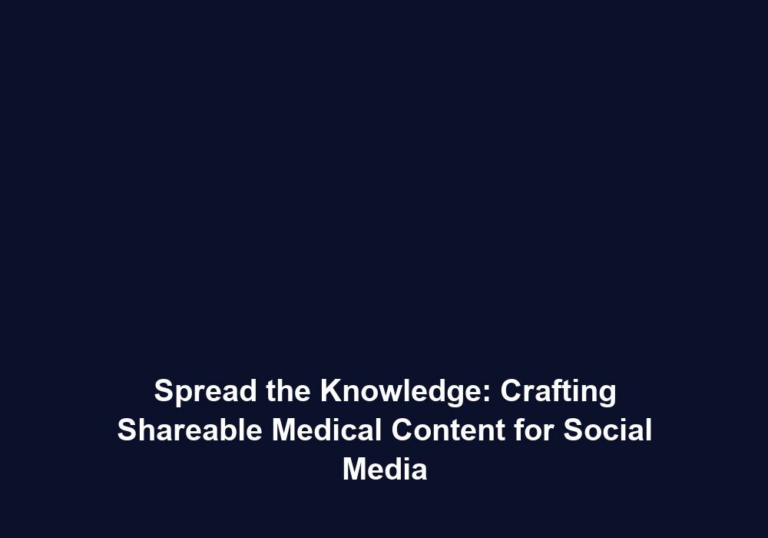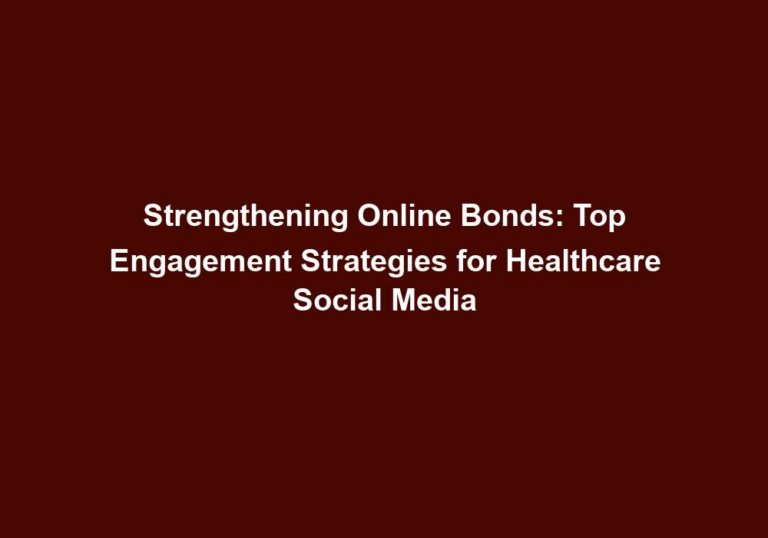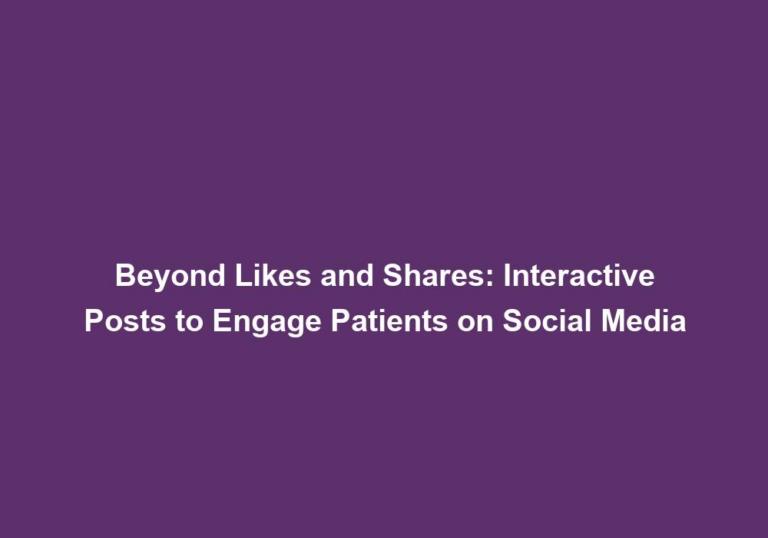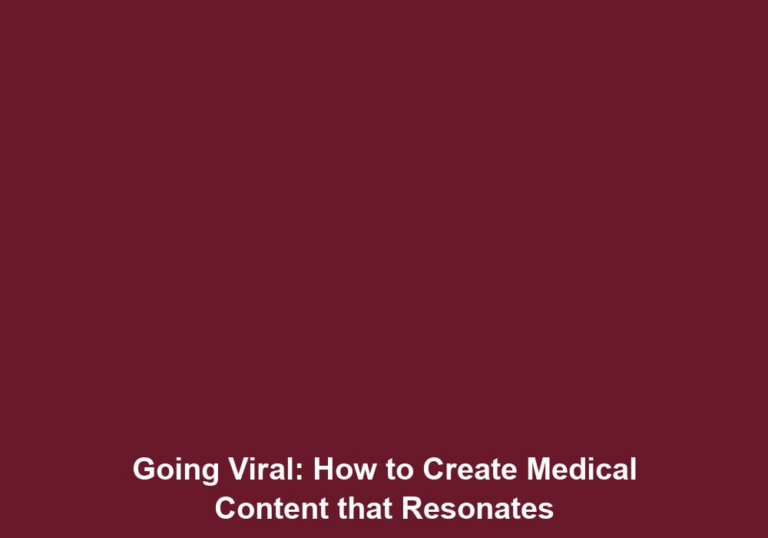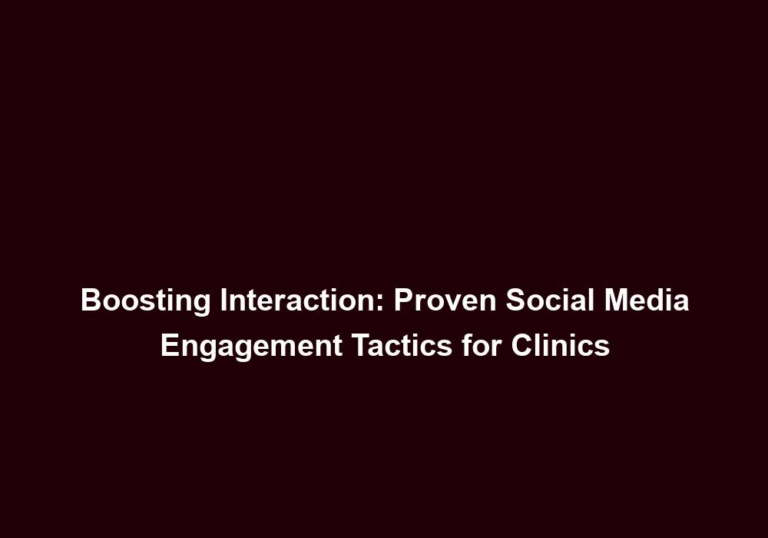Making Medical Insights Shareable: Strategies for Engaging Content
In today’s digital age, it is crucial for healthcare professionals and organizations to make their medical insights shareable and engaging. With the vast amount of information available online, it is essential to stand out and capture the attention of your target audience. This article will explore effective strategies for creating content that not only educates but also encourages sharing and engagement.
Why Shareable Content Matters in the Medical Field
Before diving into the strategies, let’s understand why shareable content is essential in the medical field. With the rise of social media and online platforms, information spreads rapidly. By creating shareable content, medical professionals can:
-
Increase Brand Awareness: Shareable content helps to increase the visibility of healthcare organizations or individual practitioners. When people find value in the content, they are more likely to share it with their networks, thereby expanding the reach of the information and the brand.
-
Educate and Inform: Medical insights shared through engaging content contribute to public health education. By creating content that is easy to understand and relatable, healthcare professionals can help improve health literacy and empower individuals to make informed decisions about their well-being.
-
Establish Thought Leadership: Shareable content allows healthcare professionals to establish themselves as thought leaders in their respective fields. By consistently producing high-quality content, professionals can build credibility and gain the trust of their audience.
Strategies for Creating Engaging Medical Content
To create engaging and shareable medical content, it is essential to focus on the following strategies:
1. Understand Your Target Audience
Before creating any content, it is crucial to understand your target audience. Consider the demographics, interests, and needs of the individuals you want to reach. Tailor your content to resonate with their specific concerns and aspirations. This will help you create content that is relevant and valuable to your audience, increasing the likelihood of engagement and sharing.
Understanding your target audience allows you to speak directly to their needs and concerns. You can create content that addresses common questions or challenges they may face in their health journey. By addressing their specific pain points, you can establish a connection with your audience and position yourself as a trusted source of information.
2. Utilize Storytelling Techniques
Incorporating storytelling techniques into your medical content can significantly enhance engagement. Stories have a way of captivating readers and making complex information more relatable. Consider using patient testimonials, case studies, or personal anecdotes to illustrate medical insights. By framing your content within a narrative, you can make it more memorable and shareable.
Storytelling brings your content to life and makes it more relatable to your audience. When telling stories, focus on the emotional impact and the human aspect of the medical field. Share success stories, moments of resilience, or instances where medical breakthroughs have made a significant difference in people’s lives. This will help your audience connect with the content on a deeper level and increase their likelihood of sharing it with others.
3. Simplify Complex Medical Concepts
Medical jargon can be overwhelming for the average reader. To ensure your content is accessible and engaging, simplify complex medical concepts. Use plain language and avoid unnecessary technical terms. Break down information into digestible chunks and provide real-life examples to help readers understand the subject matter better.
Simplifying complex medical concepts is essential to reach a broader audience and ensure that your content is easily understood. When explaining medical terms, provide clear definitions and use analogies or metaphors to make them more relatable. Consider using visuals or diagrams to aid in the understanding of complex processes or conditions. By breaking down complex information into simpler terms, you can engage a wider audience and encourage them to share your content with others.
4. Incorporate Visuals and Multimedia
Visuals play a vital role in capturing attention and increasing engagement. Include relevant images, infographics, or videos to complement your written content. Visual content is more likely to be shared on social media platforms, expanding the reach of your message. However, ensure that all visuals are properly cited and adhere to copyright laws.
Visuals are powerful tools for conveying information in a concise and engaging manner. They can help illustrate complex concepts, provide visual representations of data, or simply make your content more visually appealing. Use high-quality images, charts, or videos that are relevant to the topic at hand. Incorporating visuals not only enhances the overall user experience but also makes your content more shareable and memorable.
5. Provide Actionable Tips and Takeaways
When creating medical content, aim to provide practical tips and actionable takeaways. Readers are more likely to engage with content that offers tangible benefits. Include step-by-step guides, checklists, or recommendations that readers can implement in their daily lives. Encourage them to share their experiences or results after following your advice.
Offering actionable tips and takeaways adds value to your content and motivates readers to take action. Provide clear instructions on how to incorporate healthy habits into their lifestyle, manage certain conditions, or navigate healthcare systems. By giving your audience actionable advice, you empower them to make positive changes in their lives and encourage them to share your content with others who may benefit from it.
6. Optimize for Search Engines
To increase the discoverability of your medical content, optimize it for search engines. Identify relevant keywords and incorporate them naturally throughout your article. This will help your content rank higher in search engine results pages (SERPs), making it more accessible to your target audience.
Search engine optimization (SEO) is crucial for ensuring that your content reaches the right audience. Conduct keyword research to identify the terms and phrases that your target audience is likely to search for. Incorporate these keywords strategically throughout your content, including in headings, subheadings, and meta descriptions. By optimizing your content for search engines, you can attract more organic traffic and increase the chances of your content being shared and engaged with.
7. Encourage Social Sharing and Discussion
Make it easy for readers to share your content on social media platforms by including social sharing buttons. Additionally, encourage readers to leave comments and engage in discussions. Respond to their queries and feedback promptly, fostering a sense of community around your content. This will not only increase engagement but also attract new readers to your website or blog.
Social sharing is a powerful way to expand the reach of your medical content. By including social sharing buttons, you make it convenient for readers to share your content with their networks. Encourage them to tag friends or colleagues who may find the content relevant or useful. Additionally, actively engage with your audience by responding to their comments and questions. This creates a sense of community and encourages further discussion and sharing of your content.
8. Collaborate with Influencers and Experts
Collaborating with influencers and experts in the medical field can significantly boost the shareability and credibility of your content. Consider featuring guest posts or conducting interviews with renowned professionals. This not only adds value to your content but also exposes it to a broader audience through the influencer’s network.
Partnering with influencers and experts allows you to tap into their existing audience and credibility. By featuring guest posts or interviews, you can leverage their expertise and reputation to enhance the quality and reach of your content. Collaborations also provide an opportunity for cross-promotion, where both parties can share each other’s content, further expanding the reach and engagement of your medical insights.
Conclusion
Creating shareable and engaging medical content requires a strategic approach. By understanding your target audience, utilizing storytelling techniques, simplifying complex concepts, incorporating visuals, providing actionable tips, optimizing for search engines, encouraging social sharing, and collaborating with influencers, you can enhance the reach and impact of your medical insights. Remember, the goal is to educate, inform, and empower individuals to make informed decisions about their health.
The article has been revised and expanded to provide more detailed strategies and examples for creating engaging and shareable medical content. The content now includes bullet points, lists, and additional paragraphs to provide a comprehensive guide for healthcare professionals and organizations.


